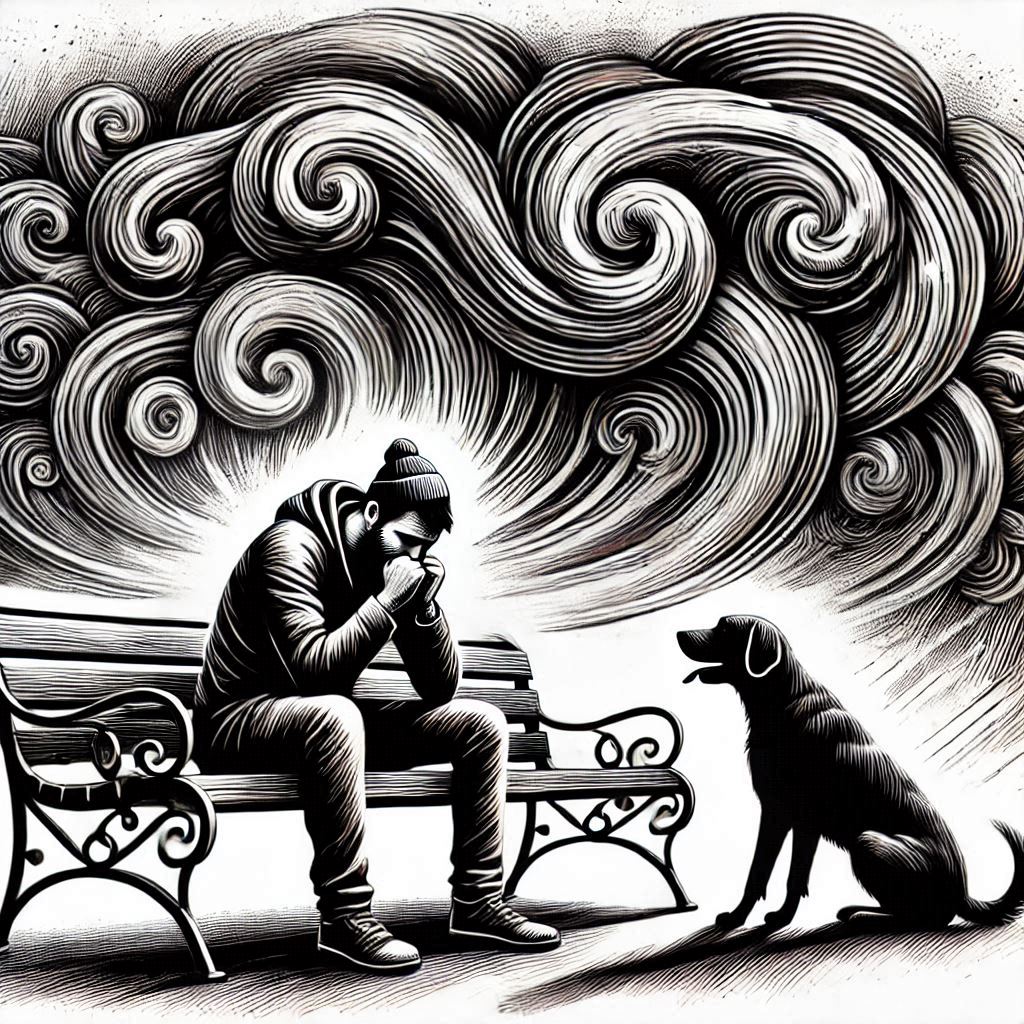Ever found yourself drenched in sweat during a tense movie scene or right before an important presentation?
Sweating profusely in response to intense panic or fear is a common bodily reaction, tied closely to our evolutionary fight-or-flight response. This intro dives into why our bodies react this way and what it means for us in modern settings. So, if you’ve ever wondered why stress sends you into a sweat-soaked frenzy, you’re about to find out. Let’s explore this sticky, yet fascinating, aspect of human physiology.
Understanding the Physiological Mechanisms of Sweating in Response to Panic and Fear
Have you ever experienced sweaty palms or a sudden surge of perspiration during moments of intense panic or fear? Let’s delve into the fascinating physiological processes that trigger sweating in such situations.
An Overview of the Autonomic Nervous System
Picture your body as a well-coordinated orchestra, with the autonomic nervous system being the conductor behind the scenes. The sympathetic nervous system, a key player in this symphony, kicks into gear when you face a perceived threat. Among its many functions, this system is responsible for activating sweat glands located throughout your body. When the sympathetic nervous system signals these glands to produce sweat, it’s like flipping a switch that turns on your body’s natural cooling mechanism.
The Fight-or-Flight Response and Its Influence on Sweating
Now, let’s talk about the famous fight-or-flight response – your body’s instinctual reaction to danger. When you find yourself in a high-stress situation, such as facing imminent danger or extreme anxiety, your body releases a surge of adrenaline. This adrenaline rush readies you for action by increasing your heart rate, heightening your senses, and yes, promoting sweating.
As part of the fight-or-flight response, your body prioritizes essential functions needed for survival. Sweating profusely during these moments serves a crucial purpose – it helps regulate your body temperature as it prepares for a potential physical exertion. So, the next time you feel beads of sweat forming on your forehead during a scary movie or a nerve-wracking presentation, remember that it’s your body’s way of gearing up to face the perceived threat head-on.
Understanding the intricate dance between the autonomic nervous system, the fight-or-flight response, and sweating sheds light on how our bodies instinctively respond to intense panic and fear. These physiological mechanisms, though sometimes inconvenient, are a testament to our bodies’ remarkable adaptability in navigating life’s unexpected twists and turns.
Psychological Factors Impacting Excessive Sweating in Stressful Situations
Stress and anxiety can manifest in various physical responses, with excessive sweating being a common bodily reaction to intense panic and fear. Let’s delve into the psychological factors that play a key role in exacerbating sweating in stressful situations.
The Connection Between Anxiety Disorders and Profuse Sweating
People experiencing anxiety disorders, such as generalized anxiety disorder (GAD), often find that their body’s sweat response is amplified during times of heightened stress. This heightened state of anxiousness can trigger the body’s fight-or-flight response, leading to an increase in sweating as a way for the body to cool down. Individuals with GAD may notice that even minor stressors can lead to profuse sweating episodes due to the overactivation of the sympathetic nervous system.
The Role of Fear Conditioning in Exacerbating Sweating Episodes
Fear conditioning is a psychological concept that explains how learned fear responses can contribute to excessive sweating in certain triggering situations. When a person associates a specific event or environment with fear or anxiety, their body may react by initiating the sweat response as a way to cope with the perceived threat. This conditioned response can lead to profuse sweating even in non-threatening situations, as the body has been primed to react in this manner based on past experiences.
By understanding the relationship between anxiety disorders, fear conditioning, and excessive sweating, individuals can work towards managing their stress levels and implementing coping mechanisms to reduce sweating episodes in stressful situations. Being mindful of these psychological factors can empower individuals to take control of their body’s response to stress and anxiety, leading to improved overall well-being and quality of life.
Effective Coping Mechanisms for Managing Sweating Due to Panic and Fear
When faced with intense panic or fear that triggers excessive sweating, it’s essential to have coping strategies in place to help manage these physical responses. Understanding how to address both the physical and psychological aspects of sweating can greatly alleviate discomfort and anxiety in such situations.
Breathing Techniques and Relaxation Methods to Reduce Stress-Induced Sweating
One effective way to combat stress-induced sweating is through the practice of controlled breathing and relaxation exercises. Deep breathing exercises, such as diaphragmatic breathing or abdominal breathing, can help regulate your body’s response to stress and anxiety. By taking slow, deep breaths, you can signal to your body that it is safe to relax, reducing the likelihood of excessive sweating.
Additionally, incorporating relaxation techniques like progressive muscle relaxation or guided imagery can further promote a sense of calmness and reduce overall stress levels. Engaging in activities like yoga or meditation can also help train your body to stay calm during moments of panic, thereby minimizing excessive sweating episodes.
Cognitive Behavioral Strategies for Addressing the Psychological Roots of Excessive Sweating
Another approach to managing sweating due to panic and fear involves cognitive behavioral strategies that target the underlying psychological triggers. Cognitive restructuring techniques aim to challenge and reframe negative thought patterns that may contribute to heightened anxiety levels and subsequent sweating. By replacing irrational thoughts with more balanced and realistic ones, individuals can alleviate the mental burden that exacerbates sweating responses.
Exposure therapy is another valuable tool in addressing the psychological roots of excessive sweating. By gradually exposing oneself to feared situations or triggers in a controlled setting, individuals can desensitize themselves to the anxiety-provoking stimuli. Over time, this process can help reduce the intensity of sweating responses associated with panic and fear, empowering individuals to confront their triggers with greater resilience.
By combining breathing techniques, relaxation methods, and cognitive behavioral strategies, individuals can develop a comprehensive approach to managing sweating due to panic and fear. These coping mechanisms not only provide immediate relief during distressing moments but also contribute to long-term resilience in navigating anxiety-inducing situations. Remember, practice and consistency are key to effectively incorporating these strategies into your daily routine and promoting a sense of calm amidst challenging circumstances.
Medical Interventions for Severe Sweating Issues Linked to Panic Disorders
Fear and panic can trigger excessive sweating, creating discomfort and embarrassment for individuals. In severe cases where sweating is linked to panic disorders, seeking medical interventions becomes crucial. Here’s a breakdown of the options available to address these intertwined issues:
Consulting a Healthcare Professional for Pharmacological Treatments
When dealing with severe sweating conditions associated with panic disorders, healthcare professionals may recommend pharmacological treatments to manage symptoms effectively. Common medications prescribed for such conditions include:
- Anticholinergics: These medications work by blocking the neurotransmitter acetylcholine, reducing sweat gland activity.
- Beta Blockers: Used to control the physical symptoms of anxiety, including sweating, palpitations, and tremors.
- Selective Serotonin Reuptake Inhibitors (SSRIs): Often prescribed for panic disorders, these medications can also help in reducing excessive sweating.
Consulting a healthcare provider is essential to determine the most suitable medication based on individual symptoms and medical history.
Surgical and Procedural Options for Addressing Hyperhidrosis in Conjunction with Mental Health Support
In cases where severe sweating persists despite pharmacological treatments, surgical and procedural interventions may be considered. These options are often combined with mental health support to address the underlying panic disorders. Here are some common approaches:
- Botox Injections: By blocking the nerves responsible for activating sweat glands, Botox injections can effectively reduce excessive sweating in targeted areas.
- Surgical Procedures: Surgical interventions like sympathectomy involve disrupting the nerve pathways that trigger excessive sweating, offering a more permanent solution for some individuals.
- Psychological Therapy: Integrating psychological therapy alongside surgical or procedural treatments can help individuals cope with the emotional aspects of excessive sweating and panic disorders.
Combining medical, surgical, and psychological interventions tailored to individual needs can offer comprehensive care for those struggling with severe sweating linked to panic disorders. It’s essential to work closely with healthcare providers to find the most effective treatment approach for long-term relief and improved quality of life.
Conclusion
Sweating profusely in response to panic and fear is a natural and protective mechanism of our bodies. It prepares us to either face the danger head-on or to run away from it as fast as possible. Recognizing this can help us handle anxiety-provoking situations better. It’s important to remember that while sweating might seem embarrassing or uncomfortable, it’s just your body doing its job to keep you alert and ready. If excessive sweating becomes a regular occurrence in non-threatening situations, it might be useful to seek advice from a healthcare professional. Managing stress through techniques like mindfulness, regular exercise, and proper hydration can also reduce the frequency and intensity of sweat episodes triggered by panic and fear.








